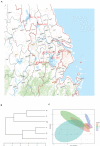Relationship Between the Fatty Acid Profiles and Gut Bacterial Communities of the Chinese Mitten Crab (Eriocheir sinensis) From Ecologically Different Habitats
- PMID: 33178151
- PMCID: PMC7593381
- DOI: 10.3389/fmicb.2020.565267
Relationship Between the Fatty Acid Profiles and Gut Bacterial Communities of the Chinese Mitten Crab (Eriocheir sinensis) From Ecologically Different Habitats
Abstract
The gut microbiota plays an important role in a variety of physiological functions such as intestinal digestion, metabolic homeostasis, immune response, and responses to disease treatment. Whether there is a relationship between gut microbial communities and fatty acid (FA) profiles of Chinese mitten crab is unclear. Hence, we analyzed the relationship between FA profiles and the gut bacterial communities of six Chinese mitten crab (Eriocheir sinensis) populations from different lakes. The crabs were sampled from six different lakes in Jiangsu Province, China. The FA profiles of these crab populations were compared and clustered, and then used to determine the relationship between geographic location and FA composition. We also characterized the gut microbial communities of these crabs using 16S rRNA high-throughput gene sequencing. The FA profiles varied significantly (P < 0.05) between crabs from different geographical locations. A similar trend was also observed in the gut microbial communities, which also varied significantly based on their geographical origin (P < 0.05). Furthermore, alpha diversity, cluster analysis, and matching bacterial community structures with specific locations revealed patterns that significantly linked FA profiles to the gut microbiota. Further analysis of FA profiles and gut microbial community generated patterns that linked the two parameters. Hence, it was observed that the gut microbial community seems to contribute significantly to the FA composition of the Chinese mitten crab. However, further studies need to be conducted to investigate the interactions between gut microbial communities and the biochemical composition of the Chinese mitten crab, which will ultimately unravel the complexity of microbial ecosystems for potential applications in aquaculture and species conservation.
Keywords: Chinese mitten crab; fatty acid profiles; fatty acids and gut microbial interactions; geographic location; gut bacterial community.
Copyright © 2020 Su, Munganga, Du, Yu, Li, Yu, Wang, He, Li, Bouzoualegh, Xu and Tang.
Figures





Similar articles
-
Phylogenetic analysis of intestinal bacteria in the Chinese mitten crab (Eriocheir sinensis).J Appl Microbiol. 2007 Sep;103(3):675-82. doi: 10.1111/j.1365-2672.2007.03295.x. J Appl Microbiol. 2007. PMID: 17714401
-
Comparative Analysis of the Symbiotic Microbiota in the Chinese Mitten Crab (Eriocheir sinensis): Microbial Structure, Co-Occurrence Patterns, and Predictive Functions.Microorganisms. 2023 Feb 21;11(3):544. doi: 10.3390/microorganisms11030544. Microorganisms. 2023. PMID: 36985118 Free PMC article.
-
Comparison of the gut microbiota and untargeted gut tissue metabolome of Chinese mitten crabs (Eriocheir sinensis) with different shell colors.Front Microbiol. 2023 Jul 13;14:1218152. doi: 10.3389/fmicb.2023.1218152. eCollection 2023. Front Microbiol. 2023. PMID: 37520354 Free PMC article.
-
Status and prospects of product processing and sustainable utilization of Chinese mitten crab (Eriocheir sinensis).Heliyon. 2024 Jun 13;10(12):e32922. doi: 10.1016/j.heliyon.2024.e32922. eCollection 2024 Jun 30. Heliyon. 2024. PMID: 38994063 Free PMC article. Review.
-
Dietary fatty acids in gut health: Absorption, metabolism and function.Anim Nutr. 2021 Dec;7(4):1337-1344. doi: 10.1016/j.aninu.2021.09.010. Epub 2021 Oct 14. Anim Nutr. 2021. PMID: 34786506 Free PMC article. Review.
Cited by
-
Application of Next-Generation Sequencing for the Determination of the Bacterial Community in the Gut Contents of Brackish Copepod Species (Acartia hudsonica, Sinocalanus tenellus, and Pseudodiaptomus inopinus).Animals (Basel). 2021 Feb 19;11(2):542. doi: 10.3390/ani11020542. Animals (Basel). 2021. PMID: 33669847 Free PMC article.
-
A high abundance of Firmicutes in the intestine of chinese mitten crabs (Eriocheir sinensis) cultured in an alkaline region.AMB Express. 2021 Oct 24;11(1):141. doi: 10.1186/s13568-021-01301-w. AMB Express. 2021. PMID: 34693464 Free PMC article.
-
Host habitat shapes the core gut bacteria of decapod crustaceans: A meta-analysis.Heliyon. 2023 May 23;9(6):e16511. doi: 10.1016/j.heliyon.2023.e16511. eCollection 2023 Jun. Heliyon. 2023. PMID: 37274665 Free PMC article.
-
Comparative Analyses of Scylla olivacea Gut Microbiota Composition and Function Suggest the Capacity for Polyunsaturated Fatty Acid Biosynthesis.Microb Ecol. 2023 Jul;86(1):575-588. doi: 10.1007/s00248-022-02046-0. Epub 2022 May 26. Microb Ecol. 2023. PMID: 35618944
-
Microbiome dynamics associated with Hematodinium sp. infection in Norway lobster (Nephrops norvegicus).Anim Microbiome. 2025 Jun 13;7(1):62. doi: 10.1186/s42523-025-00416-w. Anim Microbiome. 2025. PMID: 40514740 Free PMC article.
References
-
- Allan G. J., Max T. L. (2010). Molecular genetic techniques and markers for ecological research. Nat. Educ. Knowledge 3:2.
-
- Antony M. M. (2016). Comparative evaluation of proximate composition of Etroplus suratensis from ecologically different areas of ashtamudi lake, Kerala. Int. J. Sci. Res. 5 959–965.
-
- Barłowska J., Pastuszka R., Rysiak A., Król J., Brodziak A., Kêdzierska-Matysek M., et al. (2018). Physicochemical and sensory properties of goat cheeses and their fatty acid profile in relation to the geographic region of production. Int. J. Dairy Technol. 71 699–708. 10.1111/1471-0307.12506 - DOI
LinkOut - more resources
Full Text Sources

